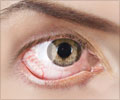During eye surgery measuring the amount of oxygen holds the clue as to why African-Americans have a higher risk of glaucoma than Caucasians, reveals study.

The study provides the first physiologic clue about the link between race and risk for glaucoma. Glaucoma is the leading cause of blindness among African-Americans. Compared to Caucasians, glaucoma is about six times more common in African-Americans, and blindness caused by glaucoma is roughly 16 times more likely in African-Americans.
"Our findings suggest there may be physiologic differences in oxygen metabolism between African-Americans and Caucasians," says first author Carla J. Siegfried, MD. "In our studies, we were not looking specifically at African-Americans, but the racial difference in oxygen levels was significant, and we believe this observation deserves further study."
They also measured oxygen in two locations near the lens of the eye in patients having cataract surgery. Oxygen was significantly higher in African-Americans at all five locations.
Siegfried, professor of ophthalmology and visual sciences at Washington University, says it's not surprising that oxygen may play a big role in the development of glaucoma because it may be a source of free radicals that damage cells. Like cataracts, glaucoma is a disease associated with aging. Oxidative stress, an imbalance between these free radicals and antioxidants, is linked to the aging process and many other age-related conditions like cardiovascular and neurodegenerative diseases.
"We began studying oxygen in the eye after our basic studies showed that it was tightly regulated there, with the lowest levels near the lens," says David C. Beebe, PhD, the Janet and Bernard Becker Professor of Ophthalmology and Visual Sciences and professor of cell biology and physiology. "Clinical studies with Nancy Holekamp (MD, professor of clinical ophthalmology and visual sciences) and Ying-Bo Shui (MD, PhD, senior scientist) revealed that exposure of the lens to excess oxygen caused the most common kind of cataracts. And our discovery about cataracts led us, somewhat surprisingly, to glaucoma. Dr. Siegfried then joined us, confirming the connection between oxygen and glaucoma, and the link between oxygen and race was yet another surprise."
Advertisement
"Glaucoma often affects African-Americans at a younger age," Siegfried says. "And when we used statistical methods to adjust for differences in age, the difference in oxygen levels between African-Americans and Caucasians became more significant. Then, when we controlled for racial differences, we found that increased age became an important indicator of elevated oxygen levels in certain locations in the front part of the eye."
Advertisement
Siegfried says it is not yet possible to say whether the elevated oxygen levels cause pressure to rise and optic nerve damage to occur, but she says higher levels of oxygen are clearly associated with factors, like race, that carry increased glaucoma risk. Her team has received a four-year grant from the National Eye Institute to further investigate that association.
Siegfried and Beebe say the next step is to extend their studies of patients and to explore the effects of elevated oxygen levels in animal models of glaucoma. They also plan to measure oxygen utilization in patients by placing a modified contact lens on the eye to measure how much oxygen is being consumed.
"It's not that older patients or African-American patients are somehow getting more oxygen into their eyes," Siegfried explains. "Rather, aging may result in lower oxygen consumption, leaving higher amounts in the eye. In contrast African-Americans may have more efficient oxygen metabolism, with the same result. The excess oxygen may result in the formation of oxygen byproducts that cause cellular damage. However, more study is required. When we understand the underlying reason for elevated oxygen and how it may damage the eye, we will be in a better position to develop ways to prevent this disease."
Source-Eurekalert













